The Transportarium (Magic Kingdom, 1994)
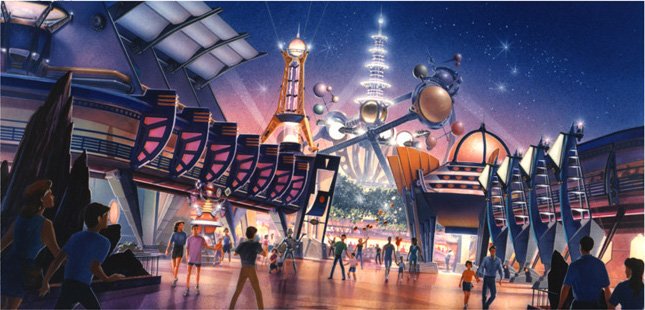
When Magic Kingdom’s renovated land finally made its debut, the Discoveryland name had been dropped. The land remained “Tomorrowland,” but you would’ve been hard-pressed to find any evidence of the real, possible future within. Instead, the land had been reimagined as a sci-fi, comic book cityscape; a “city of the future” as envisioned in comics, radio operas, and B-movies of the 1930s.
Just as elaborately retro-futuristic as Discoveryland but remixed with industrial silver and alien textures, this was a sometimes-imposing alien-urban world of gears, columns, gunmetal, domes, spheres, and metallic rings. But this New Tomorrowland didn’t just look like a real, functioning sci-fi spaceport plucked from a comic book. It was one.
Though it’s hard to imagine today, there was not one single solitary cartoon intellectual property in New Tomorrowland at all. Instead, each of the land’s rides, attractions, shows, and even restaurants were designed to fit together into one continuous, overarching story of a “real” city – one of the most ambitious original mythologies Disney has ever designed.

Entering via the new Avenue of Planets, guests would be greeted by signed erected by the Tomorrowland Chamber of Commerce, the League of Planets, and the Sleepless Knights of the Milky Way. Overhead, the trains of the Tomorrowland Transit Authority whisk by. That’s the “real” city’s “real” public transportation – and according to the on-board narrator, it’s just one line of many that criss-cross this bustling metropolis, with in-universe warnings about keeping eyes and tentacles inside the car.
After all, this is a world of landed alien saucers, neon signs in extraterrestrial languages, mechanical industrial palm trees, pearlescent domes, robotic newsboys, and alien-pianists playing at exterrestrial-owned nightclubs.
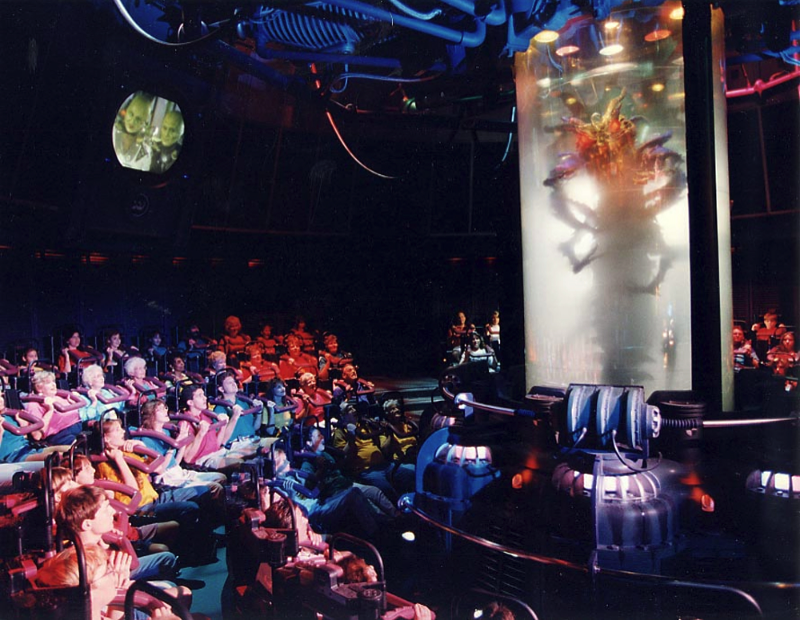
As the Tomorrow Transit Authority zips along the aerial highwys, its on-board announcer calls out the Tomorrowland Interplanetary Convention Center, where Martian technology conglomerate X-S Tech is showcasing its newest innovations in interstellar teleportation. (What could go wrong?)
Ah, and the south showbuilding? Formerly home to Circle-Vision? It’s still there. But, in the ’90s, downtowns across the United States were seeing major revivals, many racing to incorporate their own hands-on science centers filled with 3D theaters, simulators, Planetariums, and more, and downtown Tomorrowland is no different!
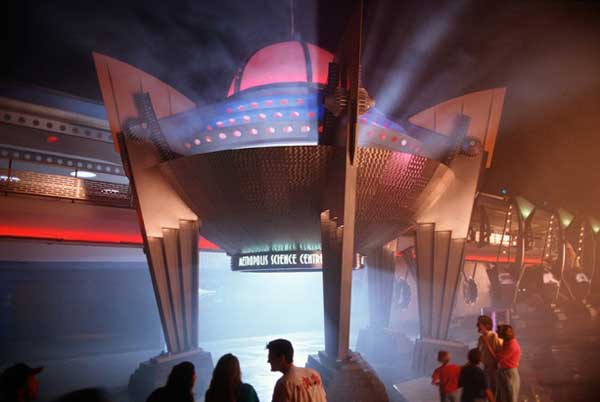
The Circle-Vision theater, too, has been absorbed into the mythos of Tomorrowland as the Tomorrowland Metropolis Science Center! (The short lived “Transportarium” location name and “From Time to Time” attraction name were dropped six months after New Tomorrowland’s debut in favor of the science center location and “The Timekeeper.”)
And given that this is a sci-fi city, a mere Planetarium won’t do… This Science Center’s newest exhibit? Time travel. Step beneath the glowing, alien saucer entry and you’ll pass into the Science Center’s inner sanctum.
THE TIMEKEEPER

How brilliant that – whether you’re in the retro-futuristic European fantasy future of Paris or the sci-fi factory pomo deco industrial future of Magic Kingdom – your experience will still “fit.” In this New Tomorrowland, the (relatively simple) queue is merely a corridor lined with bubbling, glowing tubes (very “science center”). The Timekeeper himself would now appear at the controls with an LED screen displaying the current year.
The film itself features familiar faces, like French cinema star Michel Piccoli as Jules Verne, Italian actor Franco Nero as Leonardo da Vinci, and English actor Jeremy Irons as H.G. Wells. However, a major re-cast for the American production has added some much-loved star power to Tomorrowland.
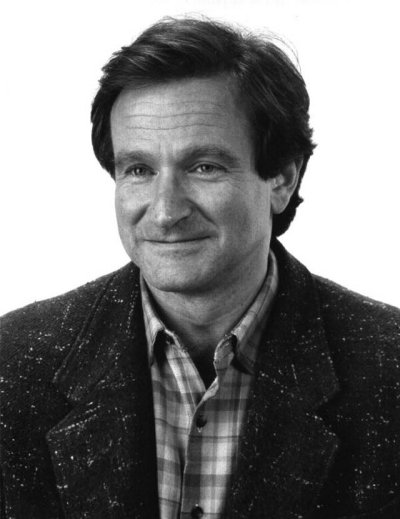
Robin Williams’ relationship with Disney began in earnest with 1987’s Good Morning, Vietman and 1989’s Dead Poet’s Society– early releases under the studios’ Touchstone Pictures banner, envisioned by Michael Eisner as a way to diversify to more adult content.
The improvizational comedian, voice actor, impersonator, and all-around entertainer had a famously bitter falling-out with Disney over a breach of contract in the marketing of 1992’s Aladdin and only reconciled with Disney in September 1995 (just in time to return for Aladdin and the King of Thieves; he was replaced in The Return of Jafar by Dan Castellaneta – voice of Homer on The Simpsons). For that reason, we have to assume that Robin signed on to voice The Timekeeper in the American production in 1992. He famously brought his comedic improvization to the character, adding incredible life and depth to the comic figure.

Meanwhile, the English role of Nine-Eye was earned by Rhea Pearlman (best known for playing Carla Tortelli in the long-running classic American sitcom Cheers).
The American version of “The Timekeeper” also made some subtle changes to the film: among them, a new score by Bruce Broughton (replacing his own French original), the removal of two scenes (hot air balloons of the USSR’s Red Square and a scene in Paris’ Charles de Gaulle airport), and the addition of a new scene: flying through New York City’s skyline. (That will become important momentarily.)
The Timekeeper opened November 21, 1994 at Walt Disney World as part of Magic Kigdom’s New Tomorrowland. Given the performances of such legendary actors, it wouldn’t be fair to try to recreate the experience in words alone any further. Only the real thing will do.
That’s why we include this point-of-view video below so that you can experience what it was like to stand before Timekeeper and Nine-Eye and bare witness to some of the greatest historical figures on Earth in a wild, wonderful, and downright fun adventure.
More than a travelogue or a history lesson, Timekeeper was a journey. Like never before, the attraction repurposed the Circle-Vision technology into a storytelling medium, adding in Audio Animatronics, legendary actors, and a time-hopping, cross-continental journey that felt equally at home in two very different visions of tomorrow.
So where is it today? The story of Timekeeper’s closure is as fascinating as its opening. The story concludes on the next page…
Changing times

Both Discoveryland and Magic Kingdom’s New Tomorrowland were ambitious and elaborate, perhaps moreso than any Imagineering projects to come before. Both bravely drew all aspects of a land – its rides, shows, shops, and restaurants – into larger-than-life frame stories, and both did it without relying on proven intellectual properties or well-known characters opting instead to invent their own.
As we know, the ’90s would see that all change. In fact, precisely because of Disneyland Paris (and its financial hardships right out the gate), CEO Michael Eisner swore off any other large scale projects and instituted strict budget cuts across the parks. The result was that – just about 25 years ago – an entire portfolio of projects at Disney was cancelled, classics were closed, and cop-out parks opened.
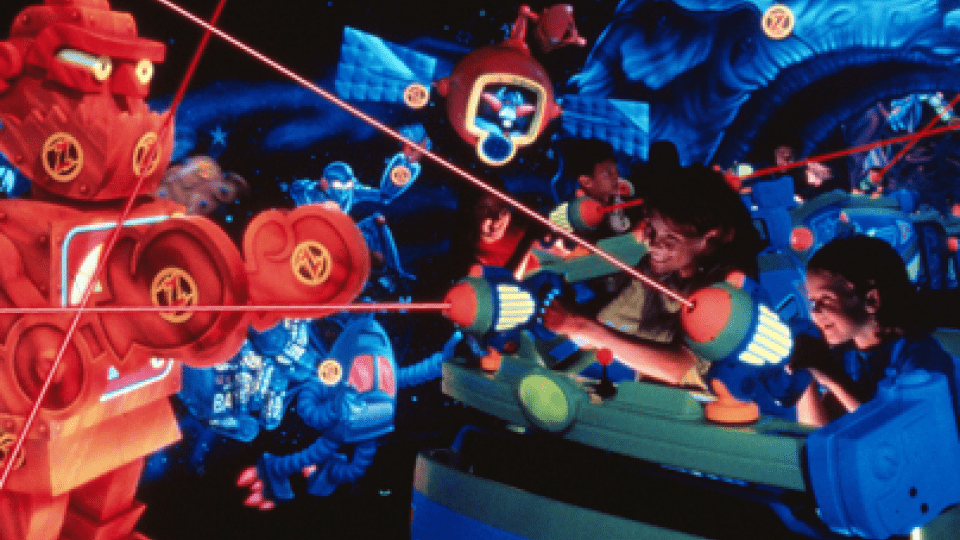
Eisner seemed to decide that Disney characters were key. At once, the best path forward was to put an end to the extravagence and originality of the “Ride the Movies” era and instead leverage the stories that had been developed by the animation studio, kicking off the “Pixarification” of Disney Parks with Buzz Lightyear’s Space Ranger Spin in 1998.
Did Disney’s ’90s attempts at “timeless Tomorrowlands” succeed? It didn’t matter: Tomorrowland was destined to become a creative catch-all for Disney and Pixar films. It seemed inevitable that an original attraction like the Timekeeper would be doomed… but then, it became certain…
The world was about to change forever. Read on as we finish up the story of the Timekeeper and see what came next…



i miss timekeeper it was awesome